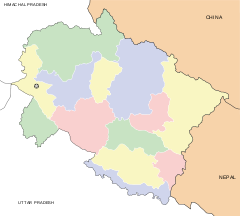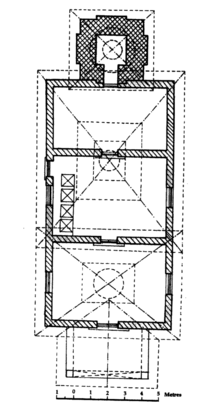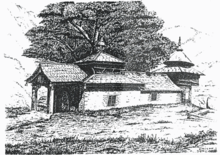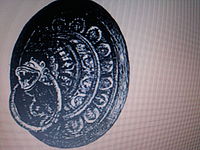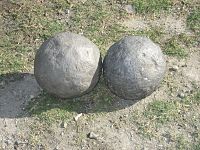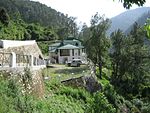- Mahasu Devta Temple
-
Mahasu Devta Temple Coordinates: 30°35′N 77°33′E / 30.58°N 77.55°ECoordinates: 30°35′N 77°33′E / 30.58°N 77.55°E Name Proper name: Mahasu Devta Temple Location Country: India State: Uttarakhand Location: Hanol, Dehradun district Elevation: 1,050 m (3,445 ft) Architecture and culture Primary deity: Mahasu Devta Architectural styles: Huna Architecture Mahasu Devta Temple is located on the Tyuni-Mori road at Hanol. The Temple is dedicated to Mahasu Devta, Lord Mahasu is the chief Deity of this area and is worshipped in Mahasu Devta Temple by the people of Hanol and nearby villages. The temple is the ancient temple of Mahasu Devta built in 9th century. The temple was constructed in Huna architectural style initially but over the ages, acquired a mixed style. The temple is included in the Archaeological Survey of India list of ancient temple in Dehradun circle, Uttarakhand.[1]
Mahasu Devta Temple is located on the eastern bank of Tons River [Tamas] at Hanol village, near Chakrata, about 180 km from Dehradun and 78 km from Mussoorie.
Hanol
The name of the village according to the legend was kept after the name of Huna Bhatt, a Brahmin. Earlier the place was known to be Chakrapur, and it is said to be the place to which the pandavas escape from laksha graha or the Lakhmandal on River Yamuna. The village is situated at an altitude of 1,050 m above M.S.L on the left bank of river tons earlier known as River Tamas (meaning short tempered). Of course it is since no water can be drawn from it for irrigation purposes, because of its precipitous banks and deep gorges. It is for this very reason the river is called Karam Nashini. According to the another tradition the water of River Tons are the tears from the eyes of Bhubruvanan.
The temple village of Hanol is a sort of pilgrimage place for people living in vast areas in the mountainous parts of Uttrakhand, west of Yamuna River, The trans giri area of Sirmaur district and major part of Shimla district of Himachal Pradesh.
Hanol is approachable from Tiuni, a well-known trijunction of roads on the Pabbar River after covering a distance of 15 km on an all-weather motorable road which meanders smoothly through the pine clad mountain slopes. Although the terrain through which the road passes is very narrow and by the another side of road one can see the river tons. Besides his ancient and principal temple at Hanol, Mahasu Devta has number of temples scattered in his deitydom. Also the temples dedicated to Mahasu Devta Birs (His two deputies) Kaulo and Shedkulia has exclusive temples for them in Theog and Jubbal. one of the temple of mahashudevta is situated in village -lakshiyar, which is 70–80 km far from dehradun. mahasudevta mandir-lakshiyar
About Mahasu Devta
In the deitydom Mahasu Devta is not only the sole arbiter over the mortals but he also reigns supreme over the innumerable indigenous gods and goddesses. He exercises his authority not only over the religious dispensation of people but over the secular matter as well. Settling upon the disputes among the people through a strange LotaPani adjuration. For this purpose water is ritually filled in a metallic goblet in the name of Mahasu Devta by a neutral person, then the disputants are asked to drink that water in the name of Mahasu Devta, the party of person who has given the false statement suffers on drinking that water.
The age old theocratic governance of Mahasu Devta, although acceptable to people and local rulers, was not taken kindly by the British authority. One of their officers, Major Young, found the authority of Mahasu Devta 'a great nuisance'. During land settlement of the territory under the British control in AD 1827 he felt that the traditional twelve-year sojourning of Mahasu (The Chalda Mahasu) with his large entourage to deitydom was extremely burdening and exploitative in common people. To check the practice, Maj. Young passed a summary order in Kalsi in an assembly of the Senyanas banishing the Chalda Mahasu and his Deputy attendants (Birs) from Jaunsar and Bawar parangna. That order however did not have lasting effect because the people regarded the Rohru tehsil for his verdict. The deity decision is always regarded as final and irrevocable.
Mahasu Devta is very touchy about the disposal of gold or gold ornaments by anyone of his subject to the outsiders. The person involved in such offence may not only suffer the loss of property or a serious disease or even life until he gets it back intact. However that does not absolve the defaulter from the crime. As a punishment the defaulter is obliged to deposit the article in the treasury of deity. Therefore the people in the deitydom have to be very careful about the transaction of silver and gold articles outside his realm. It is believed that the bullion in the Mahasudom even if in the possession of people belong to the deity. If such gold goes outside his deitydom the person doing so provokes the ire of Mahasu Devta.
Legend of Lord Mahasu
Mahasu Devta appears in quadruple form as the four brothers. The legend tells when Krishna disappeared at the end of DwaparYuga the pandavas followed him. They cross the river tons. Yudhishtra was fascinated by the beauty of place and asked Vishwakarma to build a temple here and stay here with Draupadi for nine days. The place subsequently came to known as Hanol, after the name of Huna Bhatt.
At the start of Kaliyuga demons wandered over Uttrakhand devouring people and devastating villages. The greatest demon was Kirmir who had devoured all the seven sons of pious-hearted Brahmin named Huna Bhatt. Demon cast an evil eye and desired to have the Kirtaka wife of brahman but the lady prayed to Lord Shiva to protect her chastity. Lord Shiva blinded Kirmir and thus she could run away to her husband. They then prayed to Hatkeshwari Devi of Hatkoti (ashtbhuji Durga) who advised the couple to go to Kashmir Mountains and offer prayer to Lord Shiva to help, which they did, and Lord Shiva granted them their wish that all the evils will be killed shortly.
Huna Bhatt was told to go back to his home and perform certain rituals and worship devi. On doing so the shakti emerged from the ground with flames around and told Huna Bhatt to plough every Sunday a part of his field with a plough of solid silver with a shoe of pure gold having yoked a pair of bullocks who had never been put on yoke before. On the seventh Sunday Mahasu Brothers with their ministers and the army will come out and rid the people from the clutches of demon. Huna Bhatt did accordingly, but on sixth Sunday when he had turned on five furrows out of each sprang a deity from the first came Botha from second Pavasi, out of third Vasik and Chalda from the fourth one. All the brothers were called by a common affix of Mahasu (Char Mahasu) from the fifth furrow appeared there heavenly mother Devladli Devi and there ministers, countless army sprang out like mushrooms from the field. Huna Bhatt did as directed and the whole army of the demon was killed by Mahasu brothers. Kirmir was taken by Chalda Devta in a ravine of Mount Khanda. The place still remains where the marks of his sword on the rock can be seen even today.
During the absence of Mahasu Brothers Demon Keshi had taken the control of Hanol. Chalda Devta and his warriors Shitkulia, Kaolu and others set out with the army to the mountains of Masmor Where Keshi had gone. The demon was killed thereafter Chalda Devta returned jubilantly to visit with his heroes the places named by him. He divided the country among Mahasu Brothers so that they may rule their respective territory and guard against calamities of all the people who would worship them as god and perform jagara.
However, a mistake has been erupted the venture of Mahasu brothers. In a very beginning Mahasu Devta had pledged their word to Huna Bhatt that they would appear on seventh Sunday. But since they arrived a week earlier the Mahasu Brothers were hurt by the blade of Huna Bhatt's plough who was in the field unaware of there untimely arrival. As a result Botha was hurt in knee and became lame and unable to walk. Vasik's eye was damaged by the blade of grass which impaired his vision. Pavasi had a small piece cut out of his ear. Only Chalda and Devladli Mata remained unhurt. Thereafter Botha preferred to settle within his temple at Hanol on the right bank of river tons. Pavasi keep moving over his domain and spend years turn by turn at Hanol, Lakhmandal, Authana and Uttarkashi. Chalda being sound on every limb was to exercise away in the whole dominion in Botha Mahasu name twelve years on end he spends roaming among his subjects.
Each of four deities has a Bir (attendant). They are namely Kapala, Kaolu, Kailath and shitkulia. All the Birs have Balyayinis (female helpers).
Jagara of Lord Mahasu
The Jagara celebrated for lord mahasu is quintessential to his cult and is unheard of outside his deitydom.Held in the month of Bhadon,on the eve of Naga chauth,(Bhadraprada shukla chaturtha),i.e. the fourth day of the bright half.This day is very important because the lord mahasu appeared from the ground on that day.On this occasion,during the day the images (Mohras) are ritually bathed and carried ceremoniously dully wrapped in the folds of a sheet of cloth leth,these are soiled by an ominious sight.No one is allowed to be near to the image as the deity may feel offended and curse the defaulter.After the rituals are completed the images are consigned to the altar for none to see,but one of them is kept in a Palanquin for the consummation of ceremonies during the day.By the sunset that image is also taken inside the temple and placed on altar along with others.
As the night falls,a tall and straight pole cut from Kail (blue pine) tree is planted firmly on ground.On it flag of deity is hoisted.Another pole of similar tree of much shorter length having number of forking branches is taken.Its branches are chopped off at a distance of about half o meter from the stem.So that a large squarish slate can be securely placed over the branches.This is called Chira.The goat reserved for deity is brought near the altar and offered to the deity by sprikling waterover it.If the animal shivers on sprinkling waterBijana,it signals acceptance by deity.
As night gets darker,the men and women team around with the burning torches of resinous wood in their hands.They dance in circle around chira.The fire keeps on burning on chira with more and more fuel fed to it all through the night.Dancing and singing continues around the chira throughout the night on the beat of Nagaras and other accompying instruments.At times people,men and women fall of from the circle and more and more of them takes their places so that chain is never broken.At times a man or two would drop from the circle being possessed by deity or his deputy(Shedkulia) starts shouting and crying in frenzy of divine afflatus.
In Mahabharata Era
During Mahabharat era, King Duryodhana came to Purola after travelling through Kullu and Kashmir. Duryodhana liked Purola so much that he decided to Reside here. He prayed to Mahasu Devta for piece of land. The deity accepted his pleas and made him the King of area. King Duryodhana made Jakholi as his capital village and constructed Mahasu Devta Temple. In medieval time the great Mughal emperor Akbar used to make frequent visits to Mahasu Devta Temple.
Mahasu Devta Fair
Mahasu Devta fair is held every year in the month of August. It is the most important religious fair of the local tribe of this area. Basically Mahasu Devta fair at Hanol is celebrated by Jaunsari Tribe and people of other communities also joins them. This fair depicts the cultural harmony between different communities.
There is deity idol inside the temple known as Chalta Mahasu. During fair this Deity is taken out in procession. Large crowds walk on the both sides of procession. The Prayers are continued for three whole days and nights. The prayers are accompanied by music and folk dance mainly performed by the locals and people from nearby villages. The musicians and folk dancers from various parts of dehradun and nearby districts comes to participate in this fair.
The materials for performing rituals like-Havan etc. are provided by the Government of India. Since the Mahasu Devta fair at Hanol is a local fair, The majority of people come here from nearby districts of Uttarkashi, Tehri, Saharanpur etc.
Mahasu Devta fair at Hanol is the best venue to view the cultural heritage and traditions of local tribes.
Architectural Aspects of the temple
Architecturally Mahasu Devta Temple at Hanol is one of the rarest examples of perfect and harmonious blend of stone and wooden structure to form one composite grand edifice. The sanctum proper is a pure stone shikhara in classical nagastyle. The whole wooden structure is covered with a high pitched slated pent roof surmounted by a two two tired conical canopy over it on which a gracefully tapered kalash pinnacle stands. The roof ends and the projection of balcony are ornamented with danging fringes a pendent corner bells which sway with the slightest movement of breeze.
The stone built classical sanctum sanctorum enshrines many mohras and one bronze image. Those in front row from left to right are 1) Chalda Mahasu i.e. the Mahasu who keeps on moving 2) Devladli Devi mother of Mahasu Devta 3) Kapala Bir one of the four birs (attendants) of Mahasu Devta and 4) Shedkuliya- The attendant who emits the whistling sound. Behind them in the preceding order 1) Pavasi Devta 2) Kailu-a Bir 3) Natari polyandrous wife of four Mahasu brothers, in font of all the face images is seated in a middle a small bronze image which is regarded as Botha Mahasu.
Entry to sanctum is restricted strictly for others except the Pujari even he is required to undergo ritual ablution every time he enters the celestial realms by tradition pujari of temple is a Brahmin. He is not supposed to eat meat, only eat food once a day avoid proximity with other persons, male and female during the term of his deity as pujari.
In front of sanctum is a large room which functions as an extension to the sanctum where sacramental objects are stored. This room is called Bhandar. Entry to this room is restricted to Brahmins only. The gilded door of the bhandar is very interesting. It surface is profusely embossed with human and animal figures in a very bold manner depicting the episodes associated with the birth of Mahasu Devta. The door frame is intensively covered with coins nailed over one another through years but non of them are numismatic interest and range from recent past. The lion head is fitted with a gold brass ring that serves as a handle. Such ornamental door are common in temple near east of satluj. In front of the vestibule is a sabha mandap followed by an open frontal portico. All the four apartments of this temple are roofed separately. Vestibule and bhandar have a combined three-tiered pent roof with pyramid canopy. The frontal porch has a gable roof over it supported by two wooden pillars with an intermediate ornamental arch.
Unique aspects of the temple
The most unusual aspect of the temple is the two spherical rocks about one foot in diameter. The fun part is to lift these rocks on your shoulder and head and then throwing to ground. It is believed that only pious-hearted person can only lift up these rocks.
The Hanging of trophies on the temple wall is the another unique aspect of this temple. The matches are played between team of local gods and on winning the trophy is awarded to god which is hanged on the interior walls of temple.
In the temple premises one can notice numerous sheep roaming here and there. It is believed that whatever one wishes in this temple, Mahasu Devta fulfills the wish, provided that on the fulfillment of the wish one has to bring a certain number of sheep to Mahasu Devta Temple. After prayers the sheep are set free to roam in temple premises.
Legend of Chaturmukha Naga
Nevertheless Mahasu Devta has to yield before the another powerful deity The Chaturmukha Naga of the Kotgarh-Khaneti area of the Satluj valley in the Simla district. It is said that Chaturmukha Naga happened to be the guest of the Mahasu Devta at Hanol while he was returning from pilgrimage of Kedarnath. The door attendant of Mahasu Devta,Shirpal harassed the deity and his attendant during the night and they had to spend a sleepless night at Hanol. The Chaturmukha Naga took exception to the misconduct of that attendant. He not only made his displeasures known to Mahasu Devta but also caused a man with his bullock yoked to plough ram into his temple. Mahasu Devta begged for mercy but Chaturmukh Naga can be only calmed down after the offender was surrendered to him as as captive. Shirpal later earned the confidence of Chaturmukh Naga who made him his Wazir.
Pavasi Devata Temple
Pavasi Devta is the second brother of Mahasu Devta. The Pavasi Devta Temple is just across river tons on the small hillock. The temple is about 2 km from Mahasu Devta Temple. A road from Mahasu Devta Temple goes one km downward toward the suspension bridge at river ton. On crossing the suspension bridge we enters into Thadiyar, a small village in Uttarkashi district. Then footpath goes up the hill about 1 km to reach Pavasi Devta Temple.
Accommodation
The Garhwal Mandal Vikas Nigam guest house is the reasonable and comfortable accommodation option at Hanol. It has five comfortable rooms and a dormitory. The accommodation facility is also available in the premises of temple.
Accessibility
The Mahasu Devta Temple is about 180 km from Dehradun via chakrata. It takes about seven hours from this route. The road is narrow and not good during rainy season. Another route to reach this temple is Via Mussoorie, Purola, Naugaon. This route is much better than former one and takes approximately same time to reach. The temple is also connected to Shimla via Chaupal and via Jubbal.
The Nearest airport is the Jolly Grant Airport, Dehradun. The Nearest Railway terminus is also at Dehradun.
Climate
In summers (March to May) The climate is very pleasant. Most of the pilgrims visit temple during this time.
In rainy season (July to September) there is mild rainfall. Most of the roads are slippery during this season.
In winters (November to February) the weather is chilly.
Season
Round the year
References
Hindu Temples in Uttarakhand Almora Golu Devata • Jageshwar.Nain Kalka, Vishnu templeChamoli Badrinath Temple • Gopinath Mandir • Kalpeshwar • Rudranath • TungnathChampawat Dehradun Mahasu Devta Temple • RishikeshHaridwar Nainital Pauri Garhwal Rudraprayag Guptakashi • Kedarnath Temple • Madhyamaheshwar • Rudraprayag • Triyuginarayan TempleTehri Garhwal Udham Singh Nagar Moteshwar Mahadev • Maa Balsundari • Nagnath Temple
Uttarkashi Categories:- Hindu temples in Uttarakhand
- Hindu pilgrimage sites
- Visitor attractions in Dehradun
Wikimedia Foundation. 2010.


